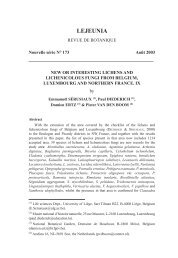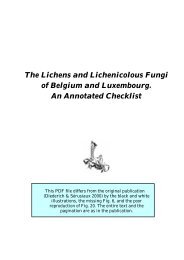A Synopsis of the Genera Skyttea, Llimoniella and - Lichens of ...
A Synopsis of the Genera Skyttea, Llimoniella and - Lichens of ...
A Synopsis of the Genera Skyttea, Llimoniella and - Lichens of ...
Create successful ePaper yourself
Turn your PDF publications into a flip-book with our unique Google optimized e-Paper software.
424 THE LICHENOLOGIST Vol. 32<br />
beginning was heterogeneous (as already noted by Sherwood et al. 1981),<br />
became more <strong>and</strong> more an assemblage <strong>of</strong> non-related species.<br />
Zhuang (1988: 62) was <strong>the</strong> first to recognize that <strong>Skyttea</strong> included a<br />
leotialean species, <strong>and</strong> she consequently transferred 5. thallophila to<br />
Unguiculariopsis, a genus with mainly fungicolous (inch lichenicolous) taxa.<br />
Later Coppins (in Rambold & Triebel 1990: 386-387) combined two o<strong>the</strong>r<br />
species, 5. lettaui <strong>and</strong> 5. refractiva into Unguiculariopsis, a genus which we<br />
know to comprise at least 10 lichenicolous species.<br />
The genus <strong>Skyttea</strong> was originally said to be related to Odontotrema<br />
(Sherwood et al. 1981), a genus with lignicolous species. Later, Hawksworth<br />
& Sherwood (1982) described <strong>the</strong> new family Odontotremataceae (Ostropales)<br />
to include Odontotrema, <strong>Skyttea</strong> <strong>and</strong> five o<strong>the</strong>r genera. A more general<br />
overview <strong>of</strong> <strong>the</strong> Odontotremataceae, toge<strong>the</strong>r with keys <strong>and</strong> descriptions <strong>of</strong> <strong>the</strong><br />
accepted genera, is provided by Sherwood-Pike (1987).<br />
Triebel (1989: 142-147) proposed to treat <strong>Skyttea</strong> in a broad sense as a<br />
recent synonym <strong>of</strong> Rhymbocarpus, <strong>and</strong> combined three known species <strong>of</strong><br />
<strong>Skyttea</strong> into that genus. Coppins et al. (1991: 51) showed, however, that <strong>the</strong><br />
type species <strong>of</strong> Rhymbocarpus has a very different ascus type <strong>and</strong> a different<br />
excipular structure, <strong>and</strong> suggested that <strong>the</strong> monotypic genus Rhymbocarpus<br />
should be best considered as Hncertae sedis pending <strong>the</strong> availability <strong>of</strong> fresh<br />
material'.<br />
The aim <strong>of</strong> this paper, initially, is to give a new circumscription <strong>of</strong> a<br />
homogeneous genus <strong>Skyttea</strong>, to discuss its systematic position, to transfer all<br />
excluded species to o<strong>the</strong>r genera, to study <strong>and</strong> solve some taxonomic problems<br />
concerning those genera, <strong>and</strong> to describe several new taxa. We did not plan a<br />
complete revision <strong>of</strong> <strong>the</strong> genus, <strong>and</strong> some well-known species presenting<br />
no taxonomic problems, <strong>and</strong> <strong>of</strong> which a modern published treatment is<br />
available, were not studied in detail. While preparing this synopsis, we<br />
examined a large number <strong>of</strong> o<strong>the</strong>r leotialean lichenicolous fungi, <strong>and</strong> we<br />
realised that a completely new arrangement <strong>of</strong> <strong>the</strong> taxa previously included in<br />
<strong>Llimoniella</strong> should be proposed, including <strong>the</strong> recognition <strong>of</strong> an enlarged genus<br />
Rhymbocarpus. As a consequence, we also prepared synopses <strong>of</strong> <strong>Llimoniella</strong> <strong>and</strong><br />
Rhymbocarpus. Some species formerly included in <strong>Skyttea</strong> or <strong>Llimoniella</strong> are<br />
excluded <strong>and</strong> are treated as species <strong>of</strong> <strong>the</strong> genus Unguiculariopsis.<br />
Materials <strong>and</strong> Methods<br />
The specimens examined are located in <strong>the</strong> institutional herbaria ASU, BG, BM, CBG, E, FH,<br />
G, GZU, H, HBG, IMI, LE, LG, LUX, M, MA, MARSSJ, NY, TRH, UC, UPS <strong>and</strong> VAB, or<br />
in <strong>the</strong> personal collections <strong>of</strong> J. Alvarez, A. Aptroot, P. van den Boom, P. Diederich, J. Etayo, K.<br />
Kalb, V. Kummer <strong>and</strong> H. T. Lumbsch. In <strong>the</strong> enumeration <strong>of</strong> specimens, <strong>the</strong> abbreviation (h)<br />
means <strong>the</strong> private herbarium <strong>of</strong> <strong>the</strong> collector. In <strong>the</strong> case <strong>of</strong> several collectors, only <strong>the</strong> first, or <strong>the</strong><br />
owner <strong>of</strong> <strong>the</strong> specimen is cited.<br />
The morphological characters (dimensions, colour, fissures, etc.) <strong>of</strong> dry herbarium specimens<br />
have been studied <strong>and</strong> illustrated with a dissecting microscope at a magnification <strong>of</strong> x 40 or x 80.<br />
Microscopical examinations (including all microscopical measurements) were carried out using<br />
h<strong>and</strong>-cut sections in water; semi-permanent preparations <strong>of</strong> some species have been prepared in<br />
lactophenol cotton blue (LCB). As almost all <strong>the</strong> herbarium specimens are at least five years old,<br />
descriptions <strong>and</strong> measurements are normally based on dead cells. The excipular pigments have<br />
been studied in water, in 5-10% KOH (K) <strong>and</strong> in concentrated nitric acid (N); <strong>the</strong> dark red





